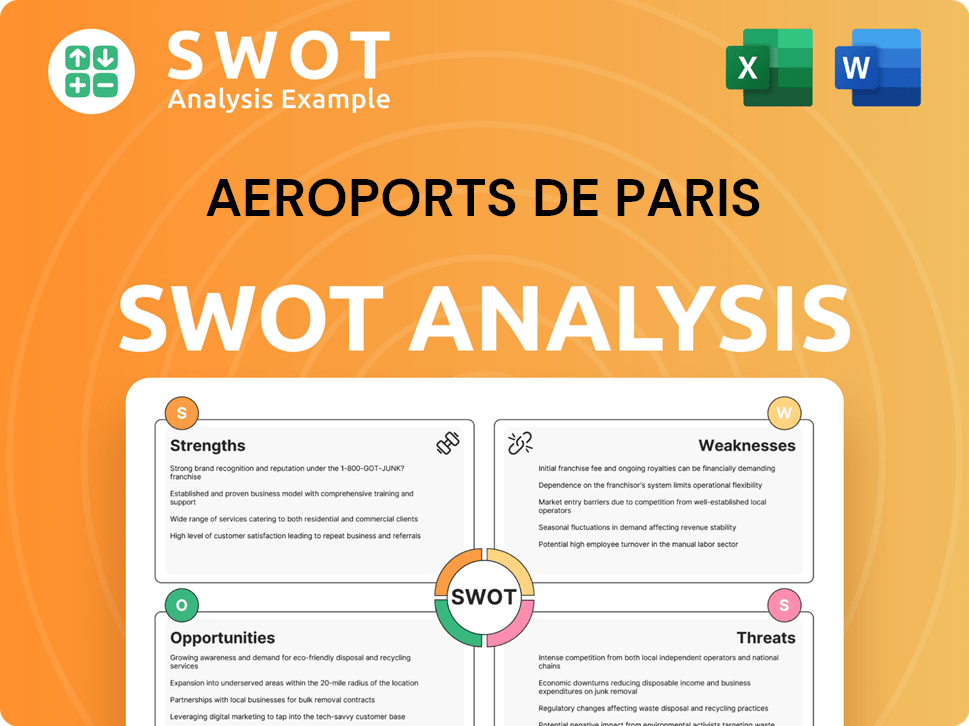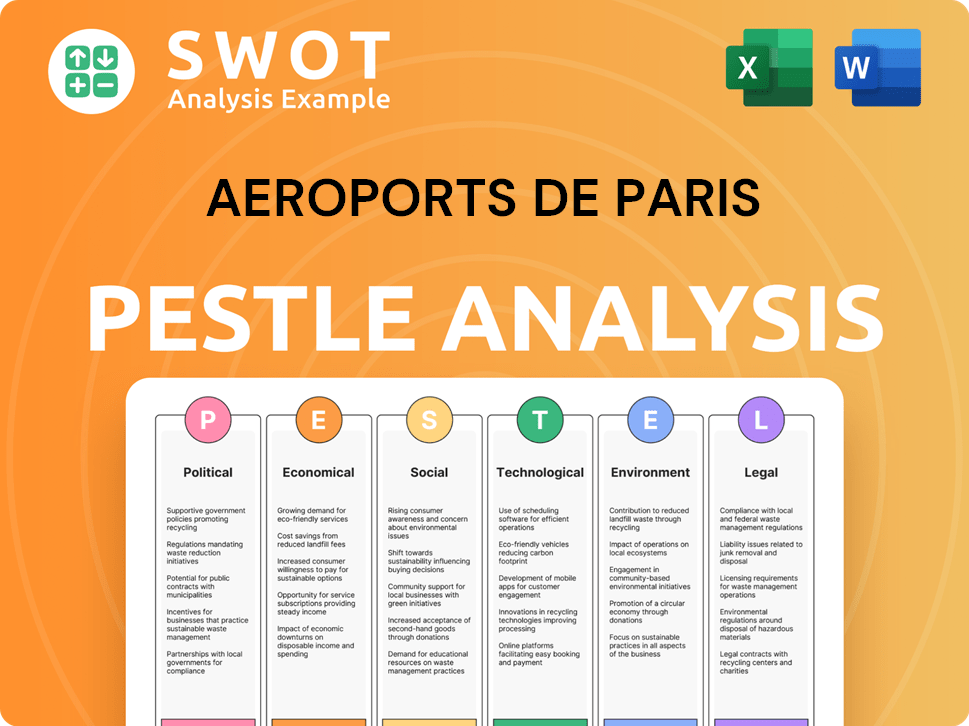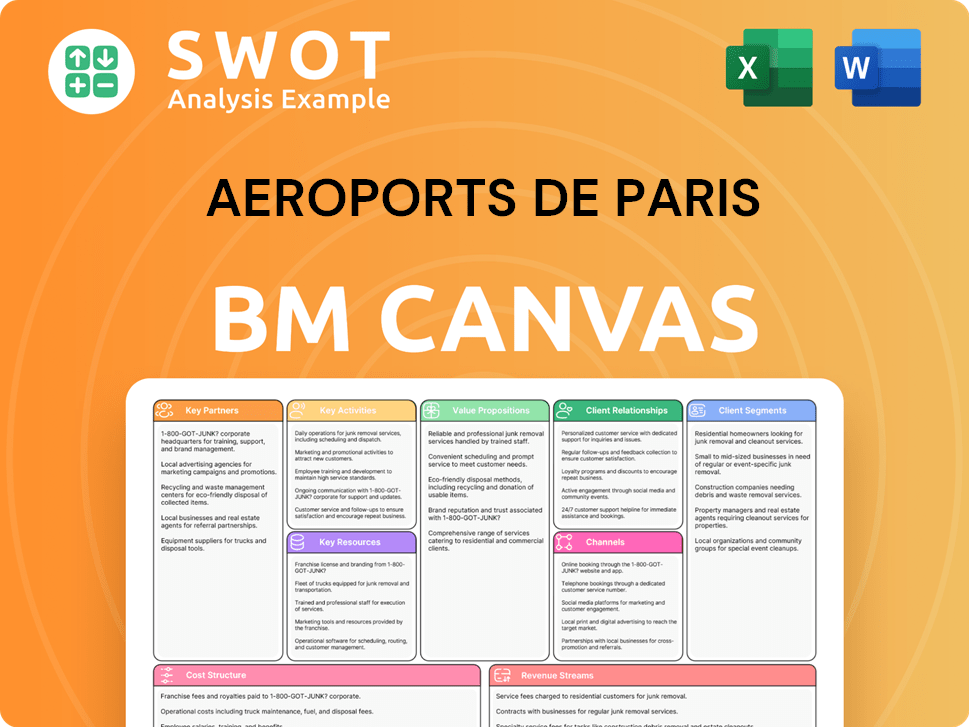Aeroports de Paris Bundle
How has Aeroports de Paris Shaped Global Air Travel?
The story of Aeroports de Paris (ADP) is a fascinating journey through the evolution of aviation. From its inception, ADP has been a driving force in transforming air travel. Understanding the Aeroports de Paris SWOT Analysis can provide deeper insights into its strategic moves.

Founded in 1945, in the wake of World War II, ADP's initial mission was to rebuild and modernize France's airport infrastructure, starting with Paris airports. This early focus on efficiency and connectivity has propelled Groupe ADP to its current status as a leading airport operator, managing key hubs like Charles de Gaulle Airport. Exploring the ADP history reveals a commitment to innovation and strategic growth within the global aviation landscape.
What is the Aeroports de Paris Founding Story?
The story of Aeroports de Paris (ADP) begins on October 24, 1945. This marked the official establishment of the company. The French government created it to manage the airports around Paris.
The main reason for its founding was to rebuild and develop airport infrastructure in the Île-de-France region. This was especially important after the damage from World War II. The goal was to create a unified and efficient system for both national and international air travel.
The creation of ADP was a strategic move by the French government. It was a response to the urgent need to repair and improve the existing airfields. The aim was to establish a strong infrastructure to support air traffic. This was seen as essential for the country's economic recovery and international relations. Learn more about the Target Market of Aeroports de Paris.
ADP was initially set up as a public industrial and commercial establishment (EPIC). Its main tasks were to design, build, and run airport facilities. This included services for airlines, passengers, and cargo. It also involved developing retail and real estate within the airports to generate income.
- Early Days of ADP: The initial funding came from the French state. This showed the importance of air travel for the nation.
- ADP's Role in Parisian Aviation: Air travel was considered vital for economic growth, trade, and diplomatic ties.
- ADP company timeline: The early focus was on rebuilding and improving the infrastructure.
- History of Charles de Gaulle airport: ADP's role included the development of key airports like Charles de Gaulle.
Aeroports de Paris SWOT Analysis
- Complete SWOT Breakdown
- Fully Customizable
- Editable in Excel & Word
- Professional Formatting
- Investor-Ready Format

What Drove the Early Growth of Aeroports de Paris?
The early growth and expansion of Aeroports de Paris (ADP) centered on modernizing and expanding Paris airports. This included significant upgrades to Orly Airport, which became a vital international hub in the 1950s. As air travel demand increased, the company recognized the need for larger infrastructure, leading to the construction of Charles de Gaulle Airport (CDG).
In the 1950s, ADP focused on rebuilding and modernizing Orly Airport. This involved extending runways and constructing new terminal buildings. By the end of the decade, Orly was handling a significant portion of international flights, showcasing early success in infrastructure development. The upgrades were crucial for handling the increasing number of passengers.
Recognizing the need for a larger airport, ADP began constructing Charles de Gaulle Airport (CDG) in 1966. The first terminal, Terminal 1, opened in 1974. CDG's development was a monumental undertaking, reflecting ADP's commitment to accommodate the booming aviation industry. The project significantly expanded ADP's operational capabilities.
ADP's growth during this period required continuous investment in infrastructure and technology. The company expanded its team to include experts in engineering, architecture, and commercial management. This expansion was driven by the increasing demand for air travel and the need for advanced airport facilities. This strategic shift positioned ADP as a key player in European aviation.
The new and expanded facilities were generally well-received, addressing the growing demand for air travel. ADP's strategic focus on developing large, modern airport hubs positioned it as a key player in European aviation. This involved navigating the complexities of large-scale infrastructure projects and adapting to a changing competitive landscape. The company's early investments set the stage for future growth.
Aeroports de Paris PESTLE Analysis
- Covers All 6 PESTLE Categories
- No Research Needed – Save Hours of Work
- Built by Experts, Trusted by Consultants
- Instant Download, Ready to Use
- 100% Editable, Fully Customizable

What are the key Milestones in Aeroports de Paris history?
The Aeroports de Paris (ADP) has a rich history marked by significant milestones in the aviation industry, particularly in the operation and development of Paris airports. The company's journey includes pivotal moments that have shaped its evolution as a leading airport operator, influencing the global aviation landscape.
| Year | Milestone |
|---|---|
| 1945 | Formation of Aéroports de Paris (ADP) to manage and develop airports in the Paris region, marking the early days of ADP. |
| 1974 | Opening of Paris-Charles de Gaulle Airport (CDG), a significant event in ADP's history, introducing innovative architectural designs and passenger flow management. |
| 1994 | ADP listed on the stock exchange, a pivotal moment in the Aeroports de Paris privatization process, opening it up to public investment. |
| 2000s | Expansion of ADP's international presence through ADP International, increasing its global footprint and diversifying its operations. |
| 2005 | The Groupe ADP was established to encompass all the activities of the company. |
| 2019 | ADP handled over 100 million passengers across its airports, demonstrating its significant role in Parisian aviation and global connectivity. |
Innovations have been a constant feature of ADP's operations, enhancing both passenger experience and operational efficiency. These advancements have helped shape the evolution of Paris airport infrastructure.
ADP implemented sophisticated baggage handling systems to improve efficiency and reduce processing times. These systems have become a standard in modern airport operations, enhancing the overall passenger experience.
The integration of high-speed rail connections, such as the TGV station at CDG, provided seamless transport options for passengers. This innovation improved accessibility and reduced travel times to and from the airports.
ADP has embraced digital technologies to enhance passenger experience and streamline operations. This includes the use of smart technologies for navigation, information, and services.
Commitment to sustainability, including the goal of carbon neutrality by 2030 for its Parisian airports. This includes investments in sustainable aviation fuels and eco-friendly practices.
Diversification of revenue streams through retail and real estate development within airport premises. This strategy enhances financial resilience and passenger services.
Continuous improvement in operational efficiency through the implementation of advanced technologies. This includes optimizing air traffic management and passenger flow.
Despite its successes, ADP has faced several challenges throughout its history, requiring strategic adaptability. The company's response to these challenges has reinforced its resilience.
Economic downturns, such as the 2008 financial crisis, significantly impacted air traffic and revenue. ADP responded by implementing cost-cutting measures and adjusting operational strategies.
The COVID-19 pandemic caused an unprecedented drop in passenger numbers, forcing ADP to adapt its operations and implement stringent cost-saving measures. This period highlighted the need for flexibility.
Competition from other major European hubs requires continuous modernization of infrastructure and services. ADP must continually innovate to maintain its competitive edge.
Security concerns, particularly after major global events, have necessitated continuous investment in robust security protocols. This ensures the safety of passengers and staff.
Diversifying revenue streams through retail, real estate, and international expansion. This strategy helps to mitigate risks associated with fluctuations in air traffic.
In 2023, Groupe ADP reported revenues of approximately €5.1 billion, indicating a strong recovery from the pandemic. The company's EBITDA reached €2.1 billion, demonstrating its financial resilience and operational efficiency.
Aeroports de Paris Business Model Canvas
- Complete 9-Block Business Model Canvas
- Effortlessly Communicate Your Business Strategy
- Investor-Ready BMC Format
- 100% Editable and Customizable
- Clear and Structured Layout

What is the Timeline of Key Events for Aeroports de Paris?
The Aeroports de Paris, or ADP, has a rich history marked by significant milestones. From its establishment in 1945, it has evolved into a major airport operator and a key player in global aviation. Key events in ADP history include the opening of Orly Airport's first modern terminal in 1952, the commencement of Charles de Gaulle Airport construction in 1966, and the airport's official opening in 1974. The integration of the TGV station at CDG in 1981 enhanced connectivity. The 1990s saw the expansion of international activities. A pivotal moment was ADP's transition into a public limited company in 2005, followed by significant investments in terminal modernization during the 2010s. On 22 February 2024, Groupe ADP released its 2023 full-year results, showcasing a strong recovery in traffic and financial performance, illustrating its resilience and growth.
| Year | Key Event |
|---|---|
| 1945 | Official establishment of Aéroports de Paris. |
| 1952 | Opening of the first modern terminal at Orly Airport. |
| 1966 | Commencement of construction for Paris-Charles de Gaulle Airport. |
| 1974 | Opening of Paris-Charles de Gaulle Airport, Terminal 1. |
| 1981 | Inauguration of the TGV station at CDG, integrating high-speed rail. |
| 1990s | Expansion of international activities and consulting services. |
| 2005 | ADP becomes a public limited company and is listed on the stock exchange. |
| 2010s | Significant investments in terminal modernization and retail development at CDG and Orly. |
| 2024 | Groupe ADP released its 2023 full-year results, showing a strong recovery in traffic and financial performance. |
The company is committed to carbon neutrality for its Parisian airports by 2030, involving investments in renewable energy and sustainable aviation fuels. This commitment aligns with broader industry efforts towards decarbonization. ADP is actively working on reducing its environmental footprint and promoting sustainable practices across its operations.
Several key infrastructure projects are expected to be completed at Parisian airports by 2025. These projects aim to enhance passenger experience and operational efficiency. These developments are essential for accommodating increasing air traffic and improving overall airport functionality.
ADP is actively pursuing international expansion opportunities, particularly in high-growth regions. The company aims to manage and operate airports globally. This strategy is a key pillar for future growth, leveraging its expertise in airport management.
Analyst predictions suggest a continued recovery in air traffic, with ADP well-positioned to capitalize on this rebound. The company's strategic location and ongoing investments support this positive outlook. ADP's financial performance history, particularly its resilience during challenging times, underscores its strong position.
Aeroports de Paris Porter's Five Forces Analysis
- Covers All 5 Competitive Forces in Detail
- Structured for Consultants, Students, and Founders
- 100% Editable in Microsoft Word & Excel
- Instant Digital Download – Use Immediately
- Compatible with Mac & PC – Fully Unlocked

Related Blogs
- What is Competitive Landscape of Aeroports de Paris Company?
- What is Growth Strategy and Future Prospects of Aeroports de Paris Company?
- How Does Aeroports de Paris Company Work?
- What is Sales and Marketing Strategy of Aeroports de Paris Company?
- What is Brief History of Aeroports de Paris Company?
- Who Owns Aeroports de Paris Company?
- What is Customer Demographics and Target Market of Aeroports de Paris Company?
Disclaimer
All information, articles, and product details provided on this website are for general informational and educational purposes only. We do not claim any ownership over, nor do we intend to infringe upon, any trademarks, copyrights, logos, brand names, or other intellectual property mentioned or depicted on this site. Such intellectual property remains the property of its respective owners, and any references here are made solely for identification or informational purposes, without implying any affiliation, endorsement, or partnership.
We make no representations or warranties, express or implied, regarding the accuracy, completeness, or suitability of any content or products presented. Nothing on this website should be construed as legal, tax, investment, financial, medical, or other professional advice. In addition, no part of this site—including articles or product references—constitutes a solicitation, recommendation, endorsement, advertisement, or offer to buy or sell any securities, franchises, or other financial instruments, particularly in jurisdictions where such activity would be unlawful.
All content is of a general nature and may not address the specific circumstances of any individual or entity. It is not a substitute for professional advice or services. Any actions you take based on the information provided here are strictly at your own risk. You accept full responsibility for any decisions or outcomes arising from your use of this website and agree to release us from any liability in connection with your use of, or reliance upon, the content or products found herein.